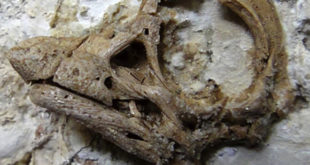A new genus and species of an early ornithopod dinosaur has been identified from two nearly complete skeletons found in China’s Liaoning Province. Changmiania liaoningensis, an anterior part of the holotype in caudolateral view; red arrow indicates the emplacement of the gastrolith clusters. Image credit: Yang et al, doi: 10.7717/peerj.9832. …
Read More »New Mass Extinction Event
The Carnian Pluvial Episode, a major climate change event that occurred around 234 to 232 million years ago (Late Triassic epoch), was a time of global environmental changes and possibly substantial volcanism. A new analysis of paleontological data suggests that this event was a major — but previously neglected — …
Read More »Carboniferous Sea Scorpion
Paleontologists have examined the fossilized remains of a previously unknown species of eurypterid (sea scorpion) and found direct evidence that these marine creatures were able to breathe in subaerial environments through their main respiratory organs. Lamsdell et al present details of the respiratory organs of Adelophthalmus pyrrhae from the Carboniferous …
Read More »India’s Gibbon Ancestor
A new genus and species of small-bodied fossil ape that lived during the Middle Miocene epoch has been identified from a fossilized tooth found in Ramnagar, India. The discovery fills temporal, morphological, and biogeographic gaps in hominoid evolution and provides new evidence about when the ancestors of modern gibbons migrated to …
Read More »Devonian Fossil Study
Paleontologists in Mongolia have found the fossilized remains of Minjinia turgenensis, a new genus and species of placoderm fish that lived 410 million years ago (Early Devonian epoch). They’ve examined a partial braincase and skull roof of Minjinia turgenensis and found extensive endochondral bone, the hard bone that makes up …
Read More »Megalodon Body Dimensions
A 16-m- (52.5-foot) long megalodon had a head 4.65 m (15.3 feet) long, a dorsal fin 1.62 m (5.3 feet) tall and a tail 3.85 m (9.4 feet) high, according to a study led by researchers from the University of Bristol and Swansea University. Paleoartistic reconstruction of a 16-m megalodon scaled against …
Read More »Wood Boring Trace Fossil
A team of paleontologists from the University of Alberta has found the fossilized tracks of a marine wood-boring organism that lived approximately 110 million years ago (Cretaceous period). Apectoichnus lignummasticans. Image credit: Melnyk et al, doi: 10.1017/jpa.2020.63. Trace fossils are biologically produced sedimentary structures that include tracks, trails, burrows, borings, …
Read More »Preserved Embryo
Paleontologists recently found well-preserved dinosaur eggs in an enormous nesting ground of titanosaurian sauropod dinosaurs that lived about 80 million years ago (Cretaceous period) in what is now Patagonia, Argentina. In a paper in the journal Current Biology, they now describe an almost intact embryonic skull from one of these …
Read More »Armored Dinosaur
Scelidosaurus harrisonii, an armored dinosaur that lived around 193 million years ago (Early Jurassic epoch), has been redescribed from a near-complete skeleton discovered over 160 years ago in England. Scelidosaurus harrisonii. Image credit: John Sibbick. Scelidosaurus harrisonii is an early armored ornithischian dinosaur whose remains have, to date, only been …
Read More »Triassic Mammal Relative
In a paper published in the journal Communications Biology, a team of U.S. paleontologists reports evidence of a hibernation-like condition in Lystrosaurus, an early relative of mammals that lived between 253 and 248 million years ago (Early Triassic epoch). The discovery was enabled by high-resolution of incremental growth marks preserved …
Read More » #Bizwhiznetwork.com Innovation ΛI |Technology News
#Bizwhiznetwork.com Innovation ΛI |Technology News









